Marta Abreu
Marta Abreu de Estévez (13 November 1845 – 2 January 1909) was one of the most influential figures of her time in central Cuba, especially in her birth city and province of Santa Clara.[1] For her constant aid to the poor, her donations to the city and the independence war, she won the title of “the great benefactor”.

Biography
Her wealth enabled Marta Abreu to travel Europe and the United States from a very young age which brought her into contact with key figures of her time and allowed her to appreciate the differences between most developed countries and her own, and how difficult Cubans had it, specially in small hinterland cities and towns. She married Luis Estévez y Romero, a lawyer[1] and University professor[2] from Havana who was also kin of the independence cause and helper of the poor; in time this allowed Marta to fulfill her philanthropic dreams. She died at her home in Paris, after having moved to Europe because of her husband's poor health.[3]
Her legacy
- Teatro La Caridad(Caridad Theater) which she built and donated to the city in order to collect money for further donations.[4]
- Asilo de Ancianos (Old people’s Home) for the elder care.
- Asilo San Vicente de Paul Asylum San Vicente de Paúl for the poor and homeless.
- El Amparo (The Shelter) another shelter for poor people.
- El Gran Cervantes (The Great Cervantes) school for black children.
- Buen Viaje school.
- San Pedro Nolasco school.
- Santa Rosalía school.
- Santa Clara weather station which she donated with all the instruments and scientific material.
- Santa Clara Firemen quarters.
- Santa Clara electrical power plant.
- Santa Clara Train Station.
- Villa Clara province gas factory.
- Three public laundry stations by the Belico river.
- Bronze statue.
 Marta's most outstanding donation, the Caridad Theater.
Marta's most outstanding donation, the Caridad Theater. Old people's home.
Old people's home. Train Station.
Train Station. Public laundry station in the Bélico river by Central street.
Public laundry station in the Bélico river by Central street. Public laundry station in the Bélico river by Martí street (today one small theater).
Public laundry station in the Bélico river by Martí street (today one small theater). Between the gazebo and children with the boot statue seats an obelisk dedicated by Marta to the founder fathers of the city.
Between the gazebo and children with the boot statue seats an obelisk dedicated by Marta to the founder fathers of the city.
Remembering Marta
- Santa Clara's University was named after her.
- A bronze statue of Marta on a chair seats in Parque Vidal.
- A room named and dedicated to her can be seen in “Casa de la Ciudad” house-museum and art gallery.
- 1947 Cuba published four stamps for the centenary of her birth (1845)
References
- Cabrera, Raimundo (1896). Louis Edward Levy (ed.). Cuba and the Cubans. The Levytype Company. pp. 345–346.
Marta Abreu.
- Marta Abreu
- "Licencia a Luis Estévez catedrático de Universidad". Archivo Histórico Nacional,ULTRAMAR,168,Exp.8. S.28079.AHN/2.3.1.15.1.4.4.23//ULTRAMAR,168,Exp.8.
D. Luis Estévez, catedrático auxiliar de la Universidad de La Habana, solicita y obtiene permiso para trasladarse a Europa con el fin de restablecer su salud
- Historical Dictionary of Cuba. Jaime Suchlicki. The Scarecrow Press. London. 1988. ISBN 0-8108-2071-4. page 3
Bibliography
- Cristobal Garcia, Angel - El teatro La Caridad. (Colección Escambray, PUBLICIGRAF (R),1993)
- Article Monument to Marta Abreu in Webshots.com
External links
![]()